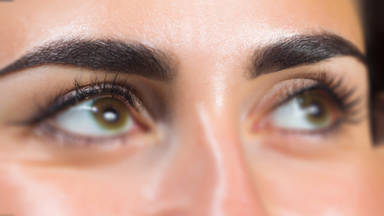
Micropigmentation and microblading are both popular semi-permanent cosmetic procedures. During this article, I will address the most frequent questions I have received regarding these cosmetic treatments.
As a lot of people have asked me whether eyebrow hachure is better than eyebrow shadowing.To answer this question, we should remember that both these methods have their own effect and beauty. The eyebrow shadow will fill in all the empty spaces in the eyebrow and will appear like a colored halo between your eyebrow hairs. In contrast, eyebrow hachure reflects the direction and grain of the eyebrow hair strands' natural growth.
No one can say which procedure is more effective for everyone, because it depends on the individual and what they want the result to look like. They're both beautiful, and it's up to you and your pigmentation artist to select the most appropriate style. It is important to stress eyebrow shadowing and hachure, be in Sombre, Ombre, or powder, are both appropriate for people with natural eyebrows or those with old tattoos.
Another question I'm often asked is whether it is possible to use shadowing or hachure to cover only parts of an eyebrow if there is an empty space above or below the eyebrow.It is possible to answer this question with a yes, as long as there is sufficient volume in the eyebrows to enable us to only apply pigmentation to the affected portion of the eyebrow. In some instances where a micro-pigmentation is being done, the eyebrows tend to be very thin and sparse, and covering only a part of the eyebrow won't be enough. For these individuals, a unified process of micro-pigmentation needs to be implemented across the eyebrows.
Several of our readers had asked a question on whether micro-pigmentation can be performed on eyebrows with old tattoos that have changed colors. Usually, eyebrow tattoos change color in a unified manner, but sometimes, they change into two colors simultaneously like red and gray. When such a tattoo is present, we will consult the individual and may suggest a tattoo removal procedure.
Question: Which procedure is better - microblading or micropigmentation?Micropigmentation is performed using an electronic hand piece. The pigmentation artist selects the depth of injection and cartridge used. There are no restrictions on skin color or skin type for micropigmentation, and it can even be applied on top of previous tattoos. Compared with microblading, micro-pigmentation can last much longer.
Micro-blading, on the other hand, is done with a specially designed handheld device that uses a specific type of blade. Micro-blading has some limitations, such as not being able to tattoo light colors on oily skin and lasting much shorter than micro-pigmentation. A microblading procedure must be restored after only six to eight months, whereas restoration of micropigmentation is entirely dependent on the individual's desire.
While micro-pigmentation can be used by anyone, micro-blading is primarily suitable for those with naturally dark brown or black eyebrows and those who wish to only fill their eyebrows for increased volume.
Question: In what way should micro-pigmentation be protected after application, and how long does it take to heal after micro-pigmentation?
In most cases, micro-pigmentation is a painless procedure without any bleeding if applied with standard equipment. Following a micro-pigmentation procedure, you can go about your normal daily activities without any problems.
Environment factors that may infect the pigmentation area should be avoided. Unless it is really necessary, you should not apply ointment to the area. Use a sterile cotton swab to apply ointment to the pigmented area if you must.
Water should not be applied to the recently pigmented area as much as possible. It's recommended that you totally avoid water during the initial three days after pigmentation. Then, you can use the recommended ointment and other materials suggested by the pigmentation artist until the next recovery cycle.
Some people have reported that they went through the micropigmentation process on their faces, but were not satisfied with the result and wanted to know whether the pigment can be removed.The pigmentation can only be removed with organic material within the first hour after going through the procedure. In the case of over one hour since application, you cannot remove the pigmentation until at least one month has passed. You can then begin to have the pigmentation removed.
There have been questions about pigmentation changing from dark brown to blue or gray after a while, and people are wondering what they can do about it. It is important that you discuss with your pigmentation artist what color mixture is appropriate for your skin type. Different skin types require different color mixtures, e.g. dark skins, yellow skins, or white skins. In order to achieve the best results, it is crucial to take the client's skin tone into consideration when mixing colors.
In order to correct gray or purple coloring side-effect, you may need to remove the pigmentation or, if the quality of the work is still acceptable, you may choose a matching color combination and design on the same pattern.
Question: If you have diabetes or are pregnant or lactating can you have micropigmentation done?
A person with diabetes must have their doctor's approval in the form of a certified description or recommendation stating that pigmentation is not an issue.
It is not safe to perform this procedure on women who are less than three months pregnant. If your pigmentation artist works with organic material that is approved by authorities, you can still perform the procedure if the pregnancy is beyond three months. If the material is not organic, you should seek advice from your doctor regarding this procedure.
Lactating women must wait for six months after the end of the lactation period before undergoing the process. Even before this time, the procedure can be performed provided organic material is used.
Question: Why did my micro-pigmentation fade within two weeks of application?
Prior to the first recovery session for micro-pigmentation, there are three stages you need to be aware of. In the first week, the area appears very bold. In the second week, it becomes somewhat faded and opaque. In the third week, it regains its color and the pigmentation starts to resemble normal colors.
During the third week, you should see how your normal pigmentation would look like. Based on what you see, you can decide whether you need to change or recover some areas, or if the design needs to be changed.
Question: Can the pigmentation removal procedure leave a red mark on the skin?
During the first week following the removal, you will see a scar on the area. Later, the scar will start to heal, the skin will peel off, and the area will look red. After a few days, the skin will begin to appear pink and after one or two months, it will begin to look more or less normal. After five to six months, it will be fully recovered. You can recover your burns and red spots faster if you use a method that uses organic material and does not damage your hair follicles.









